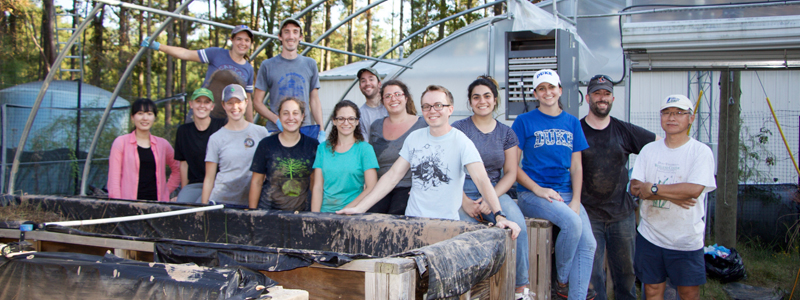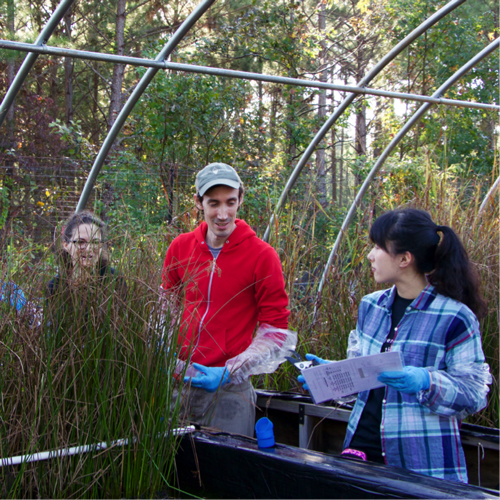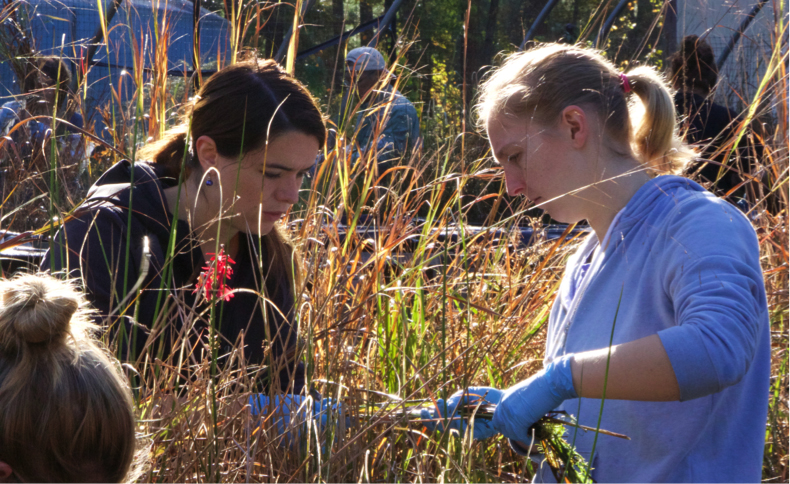Scholars Gather to Wrap Center-Wide Mesocosm Experiment
November 3, 2016
By Nick Geitner

For two weeks in October, Duke hosted students, postdocs, faculty, and technicians from all across CEINT in a massive undertaking to wrap the center-wide mesocosm experiment. Located in the Duke Forest, the experiment consisted of 24 wetland mesocosms, each its own miniature ecosystem complete with terrestrial, wetland, and aquatic plants, native invertebrates and microbes, and a school of fish.  Each mesocosm received weekly, chronic doses of one of four different nanoparticles for 9 months and was maintained at either natural or elevated nutrient levels. The ultimate goal of the experiment is to determine both local and ecosystem-wide effects of nanoparticles while also tracing where they end up in the environment. The number and variety of experimental endpoints for this project requires effort and input from a majority of CEINT-member labs, representing a wide array of disciplines. In total, the project harnesses the power of 11 labs and 10 graduate students and postdocs. Applying a variety of different nanoparticle treatments in this slow, chronic fashion allows researchers to simulate real-world exposures and illuminate any potential differences between classes of nanomaterials.
Each mesocosm received weekly, chronic doses of one of four different nanoparticles for 9 months and was maintained at either natural or elevated nutrient levels. The ultimate goal of the experiment is to determine both local and ecosystem-wide effects of nanoparticles while also tracing where they end up in the environment. The number and variety of experimental endpoints for this project requires effort and input from a majority of CEINT-member labs, representing a wide array of disciplines. In total, the project harnesses the power of 11 labs and 10 graduate students and postdocs. Applying a variety of different nanoparticle treatments in this slow, chronic fashion allows researchers to simulate real-world exposures and illuminate any potential differences between classes of nanomaterials.
Further details about the experimental design and goals may be found in an article featured on this website, Center-wide Mesocosm Experiment Has Begun.
Wrapping this phase of the project required taking thousands of different samples for ongoing examination across the Center. Water and sediment samples are being analyzed for differences in chemistry and nanoparticle concentration. Plants from each zone are subject to several measures including total biomass, growth and photosynthesis-respiration rates, stable isotopes, C/N/P ratio, and nanoparticle content. Both the enzyme activities and biodiversity of microbial communities present in the different compartments (water, sediments, plants) are being assessed as an important indicator of ecological impacts.  The true nanoparticle uptake rates of fish, clams, snails and aquatic plants are being examined, as well as the nanoparticle content of native invertebrates present in the mesocosms, ranging from tiny insects to insect and fish eating spiders (mayflies, damselflies, dragonflies, spiders…). The latter will be a key indicator of how nanoparticles may move through natural food webs and assess the rate of transfer of nanoparticles from aquatic to terrestrial ecosystems.
The true nanoparticle uptake rates of fish, clams, snails and aquatic plants are being examined, as well as the nanoparticle content of native invertebrates present in the mesocosms, ranging from tiny insects to insect and fish eating spiders (mayflies, damselflies, dragonflies, spiders…). The latter will be a key indicator of how nanoparticles may move through natural food webs and assess the rate of transfer of nanoparticles from aquatic to terrestrial ecosystems.
